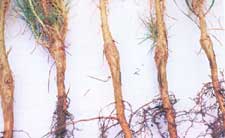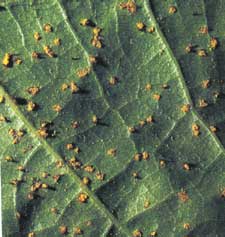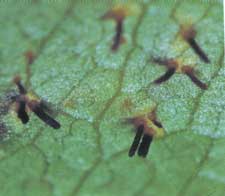Fusiform RustSamuel J. Rowan - Principal Plant Pathologist (retired), Southeastern Forest Experiment Station, USDA Forest Service, Athens, GA. Cordell C.E., Anderson R.L., Hoffard W.H., Landis T.D., Smith R.S. Jr., Toko H.V., 1989. Forest Nursery Pests. USDA Forest Service, Agriculture Handbook No. 680, 184 pp. Hosts Fusiform rust, caused by the fungus Cronartium quercuum f. sp. fusiforme, requires two hosts, southern hard pines and oaks, to complete its life cycle. Thirty-two species of pines are susceptible to the disease. Slash, loblolly, and South Florida slash pines are highly susceptible; long-leaf and pond pines are less susceptible; and pitch and shortleaf pines are relatively resistant. Members of the black oak group are the most common alternate hosts of the fungus, but 33 species of oaks are susceptible to the disease. Four species of chestnut and two species of chinkapin and tanoak also are susceptible. Distribution Fusiform rust is indigenous to the Southern States from Maryland south to Florida and west to Arkansas and Texas. The incidence of the disease is highest in a zone approximately 150 miles wide, extending from the coast of South Carolina to Texas. Damage Fusiform rust is the most serious nursery disease of slash and loblolly pines. No mortality occurs in the nursery, but infected nursery seedlings rarely survive the first year of outplanting. All infected seedlings must be culled.
Look for orange urediniospores (fig. 8-2) and brown, hairlike teliospores (fig. 8-3) on the underside of oak leaves in the vicinity of the nursery. These spores are visible to the naked eye during the spring and early summer. The presence of urediniospores and telia on oak leaves indicates that susceptible pine seedlings in nearby nurseries will likely be infected. Biology This rust fungus is an obligate parasite requiring live host tissue for its survival. Aeciospores that are produced on pine galls in early spring infect expanding oak leaves. A few weeks afterwards, uredinial pustules develop on infected oak leaves; the uredinial pustules produce urediniospores, which may reinfect other young oak leaves. As these infected leaves mature, telia appear and produce basidiospores. The basidiospores are produced from spring to early summer during periods of high humidity and moderate temperatures, and infect new pine needles and shoots. Control Prevention - Use of seed from genetically improved or geographically selected rust-resistant stock is the most effective and practical long-range approach to lessening the impact of this disease. Cultural - Cull infected seedlings. Only rust-free seedlings should be shipped from the nursery. This is difficult under the prevailing practice, which bases seedling sales on weight rather than number. This practice prevents individual seedling examination and places heavy reliance on chemical control. Removing susceptible oaks and infected pine from within 1 mile of the nursery may also provide some degree of control. Chemical- Infection can be prevented by applying ferbam or triadimefon. A spreader sticker is usually added to improve coverage and reduce weathering of fungicides. The frequency, timing, and coverage of fungicidal sprays are important for effective control. Apply foliar sprays of ferbam two to three times each week and after rains from seedling emergence to mid-July. Apply triadimefon first as a seed treatment. Then follow with three to four foliar sprays spaced equally between 3 weeks after sowing and June 10. Triadimefon, which has systemic activity, has largely replaced ferbam for controlling fusiform rust in southern nurseries. Selected References Czabator, Felix J. 1971. Fusiform rust of southern pines-a critical review. Hes. Pap. 80-65. New Orleans, LA: U.S. Department of Agriculture, Forest Service. Southern Forest Experiment Station. 39 p. Dinus. H.J.; Schmidt, HA., eds. 1977. Management of fusiform rust in southern pines: symposium proceedings: 1976 December 7-8: Gainesville, FL. Gainesville, FL: University of Florida. 163 p. Rowan, S.J. 1977. Incidence of fusiform rust in Georgia forest tree nurseries, 1959- 1973. Tree Planters' Notes. 28(2): 17-18, 29. Howan, S.J.; Cordell. CE.; Affeltranger, C.E. 1980. Fusiform rust losses, control costs, and relative hazard in southern forest tree nurseries. Tree Planters' Notes. 31(2): 3-8. |
Forest Pests: Insects, Diseases & Other Damage Agents |

|
|




